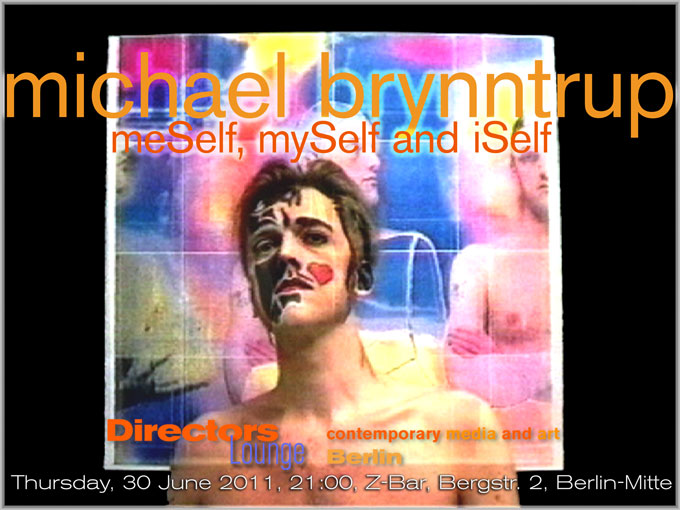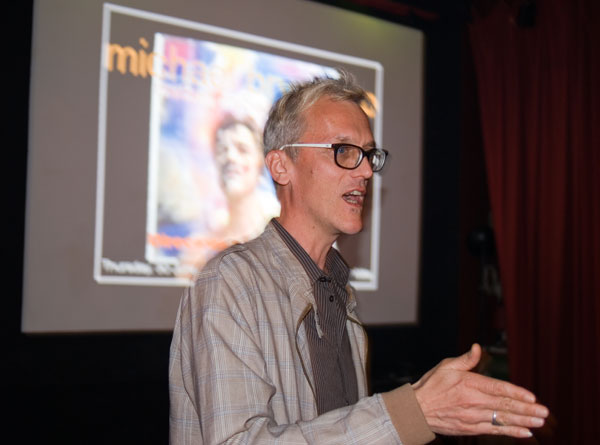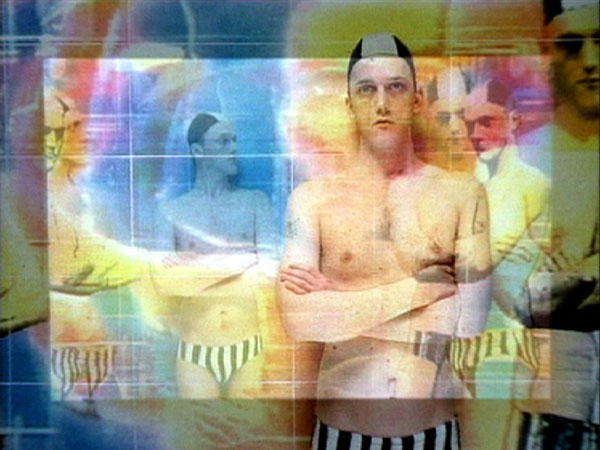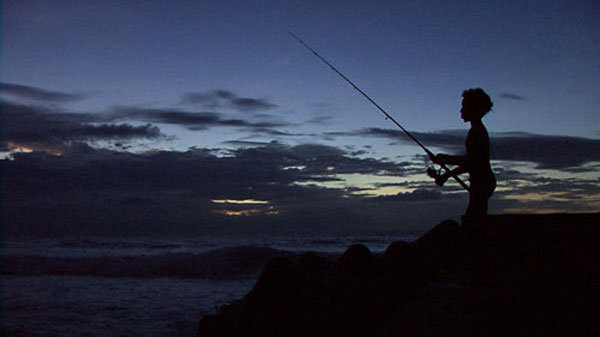 |
michael brynntrup —
meSelf, mySelf and iSelf
film and video works
Thursday, 30 June 2011
21:00
Z-Bar
Bergstraße 2
10115 Berlin-Mitte
Michael Brynntrup is an artist and filmmaker who has been probing the limits of independent, personal and experimental film since the 80's. Very early in his art career, he started off with Super-8 films, but soon experimented with multiple projections and collaborations with other artists. With "Jesus, der Film" his collaboration took the form of a "cadavre exquis", the joint product of a number of directors who only saw part of the work of their colleagues, but who all were asked to have Brynntrup play the main character, Jesus. The resulting feature-length film became a legend, while a little later, Brynntrup also became a well-known director in the gay-and-lesbian cinema movement. His goal, however, was always to avoid monopolization by a certain scene, and thus, from the start, he has strived for a diversity of themes and genres in his work. Still, we can find the repeated and ongoing questions of the identity of the self, of how the roles we play in society are defined by gender and sexual orientation, and of how the mirror of the other — and the mirror of death — influence our lives.
In many of his films, Michael Brynntrup plays the main protagonist, and sometimes he is the only character appearing. These films are radically based on the reflection of the "Self". However, the artist does not play on self-indulgence, or self-complacent mirroring. To him, these kinds of self-projections are more interesting if played out by other people, like in his films with drag queens. On the contrary, it is a practice of self-inquiry, a search for universality, the conditio humana or maybe the "conditio artifices", the conditions of being an artist. It is not the usual psychoanalytical dismantlement, or the theosophical-modernist inquiry for the hidden truth, concealed by the surface that the artist is seeking. But it is the interrogation of the image itself. Nothing is concealed, but everything is to be read. In this sense Brynntrup is postmodern, a heretic to the spiritual inquiry of film modernity, a man who — in contrast to spiritual seekers like Stan Brakhage and Bill Viola — does not offer pre-digested answers, but has uncomfortable questions to ask.
The image, the re-photographed image, the image of his artwork, his diary, his work-space, the list of his lovers and so on, are a mirror to the artist's self. A self that is looking at itself like a sample of the human race, an instance of the species called "artist", or an example of the minority called "homosexual". However, there is a catch after all: We, all of us, are somebody "totally different" when looking into the mirror. Those who have watched their partners or best friends looking in the mirror may have hardly recognized their loved ones. We transmute ourselves under the auspices of our own critical gaze. This transformation is even evident in the long tradition of the "self-portrait", in painting, photography, film and video. The effigy of the painter at the easel I am thinking of Max Beckmann or Lovis Corinth, and their hard-to-endure gaze of the depicted may give us a slight shiver. It is thus no accident that if those who cannot adapt to society, neither in their social role nor their looks, make portraits of themselves, their personal photographic testimonials turn into masquerade. Such is the case with Claude Cahun, whose self-depictions later — and belatedly — became icons of the photographic canon of modernity. Here, the masked or the painted face does show more of the self and its relation to society than the "unfortified" reflection.
It is thus no coincidence that Michael Brynntrup also turns towards the portrait in a number of his films, and towards the masquerades of the people portrayed. For "Achtung — Concentration Chair" (Attention — Concentration Chair), made over several years, he used a found chair made of wire grating as a studio prop. It served for portraits of six men and a pregnant woman while focusing on their tattoos, piercings, scars and skins. In his film series on death, "Totentänze" (Danse Macabre) "Plötzlich und unerwartet, der Elephant aus Elfenbein", in each part of the series one artist acts in correlation with a skull. Here, the solo performance in each film becomes a portrait — a portrait wearing the mask of death. Under the sign of AIDS, this bears quite a tragic symbolism; however, these films stand in the much older tradition of death dance, "danse macabre", and the topic of disease and early death.
Still, we could proceed further and say: on a final level, the gaze into the mirror of media does only reflect on itself, the media gaze. Artist Brynntrup, being very aware of this, uses endless arrays of self-references, self-quotations and their alterations in his works. In "Herzsofortsetzung", his self-portrait is duplicated so that the variations start to be unrecognizable copies of the original, being used as wallpaper for another self-portrait cycling through another repeated process of replication. Then in "Blue Box Blues", the video shows a photo shooting of a lesbian couple (Brynntrup in the role of the photographer) that changes in its repeated reflection of "making of", the representation of which thus becomes more and more remote. The resulting alienation of the viewer seems to be a calculated means to prompt one to think about the real relationship between the women in front of the camera. However, the two retreat from the viewer into an almost hermetical embrace. The erotically charged setting thus does not feed much into the viewer's voyeuristic expectations. Maybe "Blue Box Blues" can be read as a key for understanding Michael Brynntrup's media reflection as part of his style, aiding the critical reading of his work and the decipherment of his self-irony. Even while singing along with the karaoke of "Girl of Ipanema", one must remember that independent media production is always both informational self-determination and pure self-projection inside the media, as it was seen by Vilém Flusser. "Truth" thus may only be a projection. Or, saying it differently, if according to Marshall McLuhan, "The Medium is the Massage" (one of his late books), we shall not wonder if Brynntrup is kneading us against the grain, and that it might pinch hard at some very sensitive parts.
A special highlight of the night is "Totale Mondfinsternis über dem Meer" ("Total Lunar Eclipse over the Ocean"). The film first seems to be antithetical to Michael's other films, both aesthetically and in its content: no rapid sequences of images, no charged storyline, but an extended meditation, supported by an overwhelming soundscape. A boy with full lips and curly hair stands in the hard contrast of frontlighting at the seaside. Then, minimal breaks happen. Small artificial incidents take place in the image, irritating the meditation, urging the viewer to ask for the intended meanings — are these symbolic references, or a pure reflection of self-contained media? Meanwhile, the viewer is never released from the ongoing image seduction.
Program:
• HERZSOFORT.SETZUNG II (autogene Manipulationen) | HEART.INSTANT/IATION II (Autogenous Manipulations) 7:15 min | 1996 | BetaSP + 16mm | col | sound
• Totale Mondfinsternis über dem Meer | Total Lunar Eclipse Over the Ocean 15:00 min | 2011 | HD (16:9) | col | sound (5.1)
• DAS ELFENBEIN - Totentanz 1-3 | THE IVORY - Death Dance 1-3 | 10 min | 1988 | 16mm | col | sound
• DER MENSCH - Totentanz 4 | HUMAN BEING - Death Dance 4 | 6 min | 1989 | 16mm | col | sound
• STUMMFILM für Gehörlose | SILENT MOVIE For Deaf People 5:40 min | 2002 | flash | 16mm bw + col | sound
• NY 'NY 'n why not 4:00 min | 1999 | 35mm | col | stereo
• ACHTUNG - die Achtung (concentration chair) 14 min | 2001 | 35mm | bw + col | stereo
• IPANEMA lip-synch 3:15 min | 2003 | DV | col | stereo
• BLUE BOX BLUES (die Inszenierung einer Fotografie) | BLUE BOX BLUES (Staging a Photo Shoot) 7:40 min | 2004 | DV | col | stereo
• TABU V (wovon man nicht sprechen kann) | TABU V (About Which One Cannot Speak) 13 min | 1998 | 16mm | col | sound
• Vorfilm zu EKG101 | Opening scene to EKG101 | 1 min | 2002
Artist Link:
Michael Brynntrup
http://www.brynntrup.de/
Links:
Directors Lounge
http://www.directorslounge.net
oder
http://directorsloungenews.tumblr.com/post/6971431832/brynntrup
Z-Bar
http://www.z-bar.de
 Back Back
|
 |





